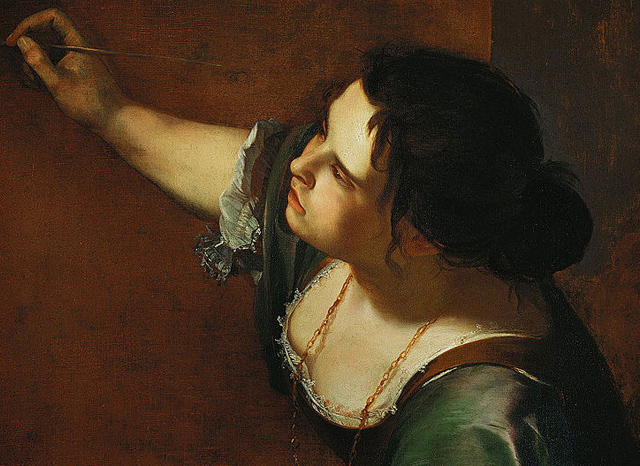
In una professione dominata dagli uomini, una donna si distingue. Artemisia Gentileschi. Nacque a Roma nel 1593. Nella sua epoca e ancora oggi è uno dei pittori più compiuti nella generazione successivo a quello di Caravaggio. In un momento in cui le donne pittori non furono facilmente accettate dai loro contemporani nella comunità artistica, fu la prima donna a diventare un membro dell’Accademia di Arte del Disegno di Firenze.
In a profession dominated by men, one woman stands out. Artemisia Gentileschi. She was born in Rome in 1593 and today is considered one of the most accomplished painters in the generation following that of Caravaggio. In a time when women painters were not easily accepted by their peers into the artistic community, she was the first woman to become a member of the Accademia di Arte del Disegno in Florence.
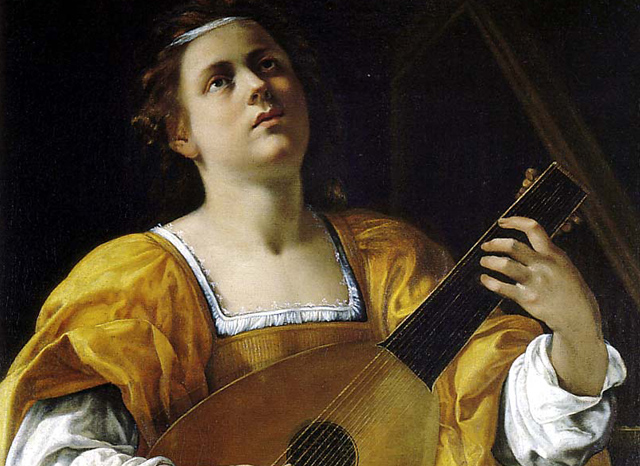
Il chiaroscuro di Artemisia è un suo tratto caratteristico, con effetti di luce che ci fanno pensare allo stile di Caravaggio. Poiché il lavoro di suo padre ha preso ispirazione da Caravaggio, anche il suo stile è stato a sua volta fortemente influenzato. Alla fine, però Lo stile di Artemisia ha eclissato l’opera di suo padre. A differenza di altri artisti femminile che rappresentavano natura morta e ritratti, Artemisia dipinse soggetti storici, biblici e mitologici.
Artemisia’s characteristic chiaroscuro, featuring a bold spotlight effect in many ways is reminiscent of Caravaggio’s style. Since her father’s work took inspiration from Caravaggio, her style as well as heavily influenced in turn. But Artemisia eventually eclipsed her father’s. Unlike other female artists who rendered still life and portraiture, Artemisia specialized in history painting, Biblical stories, and mythical subjects.
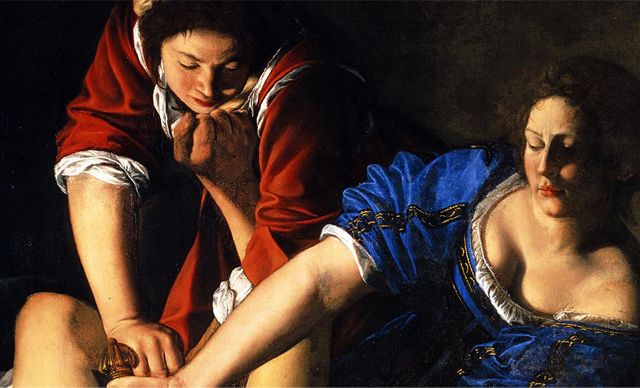
In giovane età Artemisia fu vittima di uno stupro e fu costretta a subire un processo pubblico ben documentato che durò sette mesi. Fu violentata dal pittore Agostino Tassi che il padre aveva assunto come maestro di pittura. Durante il processo, Artemisia fu sottoposta ad una esame ginecologico e fu anche torturata con l’uso di viti per verificare la sua testimonianza. Alla fine del processo Tassi fu condannato al carcere per un anno, anche se non ha mai scontato la pena.
At an early age, Artemisia was the victim of rape and she was forced to endure a well-documented public trial that lasted seven months. She was violated by the painter, Agostino Tassi who her father had hired to tutor her in painting. During the trial, Artemisia was subjected to more than one gynecological examination, as well as torture using thumbscrews to verify her testimony. At the end of the trial, Tassi was sentenced to imprisonment for one year, although he never served the time.
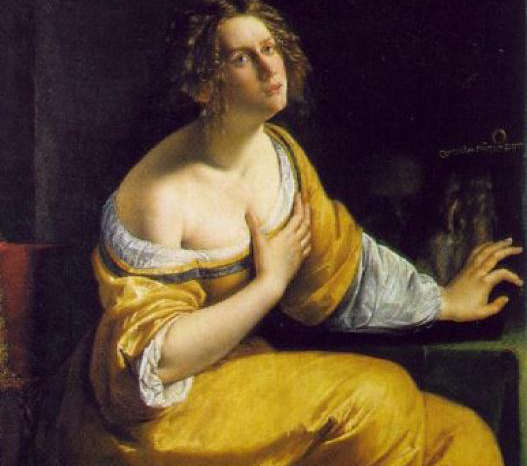
Artemisia portò al suo lavoro un senso elettrico del dramma narrativo e una prospettiva unica che sia celebrato che umanizzati forti personaggi femminili. Ma è il dipinto incredible, quello di Giuditta che decapita Oloferne che incarna la sua carriera. Artemisia scelse di dipingere la scena biblica al raccapricciante culmine della storia, in cui la vedova Giuditta, taglia la testa del generale Assiro che ha bevuto troppo, per impedirgli di distruggere la sua città di Betulia. Il quadro è drammatico e terrificante nel suo realismo, come si può vedere dal coltello che taglia il collo del general e dal sangue che sgorga.
Artemisia brought to her work an electric sense of narrative drama and a unique perspective that both celebrated and humanized strong women characters. But, it is the sensational painting, that of Judith Slaying Holofernes that epitomizes her career. Artemisia chooses to paint the biblical scene at the story’s gruesome climax, as Judith a widow, cuts the head of the Assyrian general who has passed out from drink, to keep him from destroying her home city of Bethulia. The picture is dramatic and terrifying in its realism as one can see from the knife slicing into the general’s neck and the blood that spurts out.
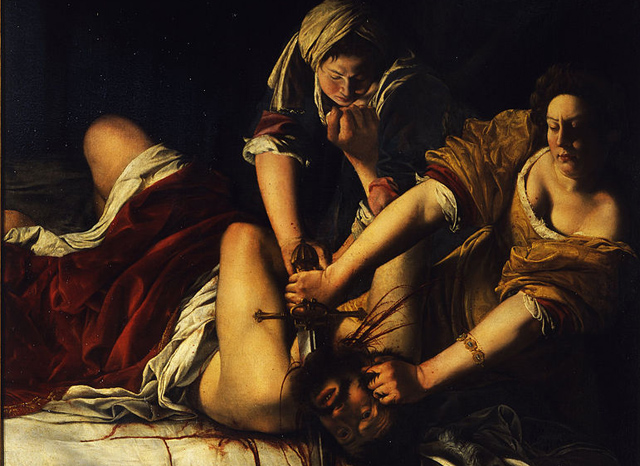
Nel 19º secolo gli studi femministi hanno portato in evidenza l’episodio di stupro e il terrore di base e il maltrattamento della vittima, sostenendo che questo incidente ha alimentato il suo spirito creativo, nel tentativo di vendicarsi e di ribellare contro una società dominata dagli uomini. Altri sostengono che Artemisia astutamente ha approfittato della sua fama dal process per stupro per soddisfare una nicchia di mercato maschile, con i quadri caricati di violenza e energia sessuale.
In the 19th century, Feminist studies brought into evidence the rape incident and the underlying terror and mistreatment of the victim, claiming that this incident fueled her creative spirit in an attempt to seek revenge and rebel against a male-dominated society. Others claim that Artemisia shrewdly took advantage of her fame from the rape trial to cater to a niche male market, with paintings loaded with violence and sexual energy.
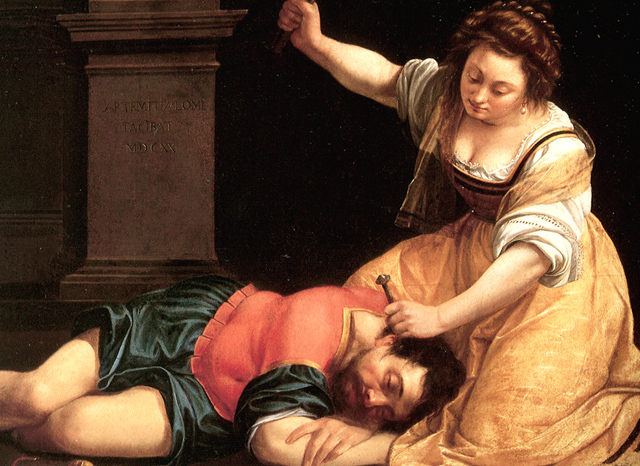
Anche se la sua storia complicato e il processo dello stupro ha messo in ombra la sua vita e la carriera, e per un gran parte della sua vita era considerata una curiosità, alla fine è continuato in avanti con la sua vita. Si è sposata e ha lasciato Roma per vivere e lavorare a Firenze dove ha goduto enorme successo. Ha mantenuto buoni rapporti con gli artisti più apprezzati del suo tempo, tra cui il Granduca Cosimo II de Medici. Era anche amica di Galileo Galilei, dimostrando che non si può tenere il talento e donna in gamba verso il basso per molto tempo!
Although her complicated past and rape trial overshadowed her life and career and she was considered a curiosity, she eventually did move on with her life. She married and left Rome to live and work in Florence where she enjoyed huge success. She maintained good relations with the most respected artists of her time, including the Granduke Cosimo II de Medici. She was also a friend of Galileo Galilei, proving you can’t keep talent and a good woman down for long!



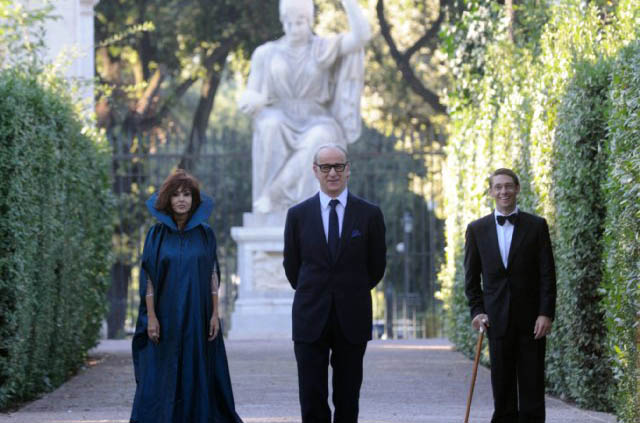
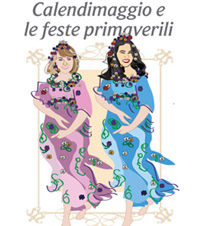







Grazie mille per questo blog! Sono una fan di Artemisa Gentileschi, una talentosa pittora e una personalità affascinante.